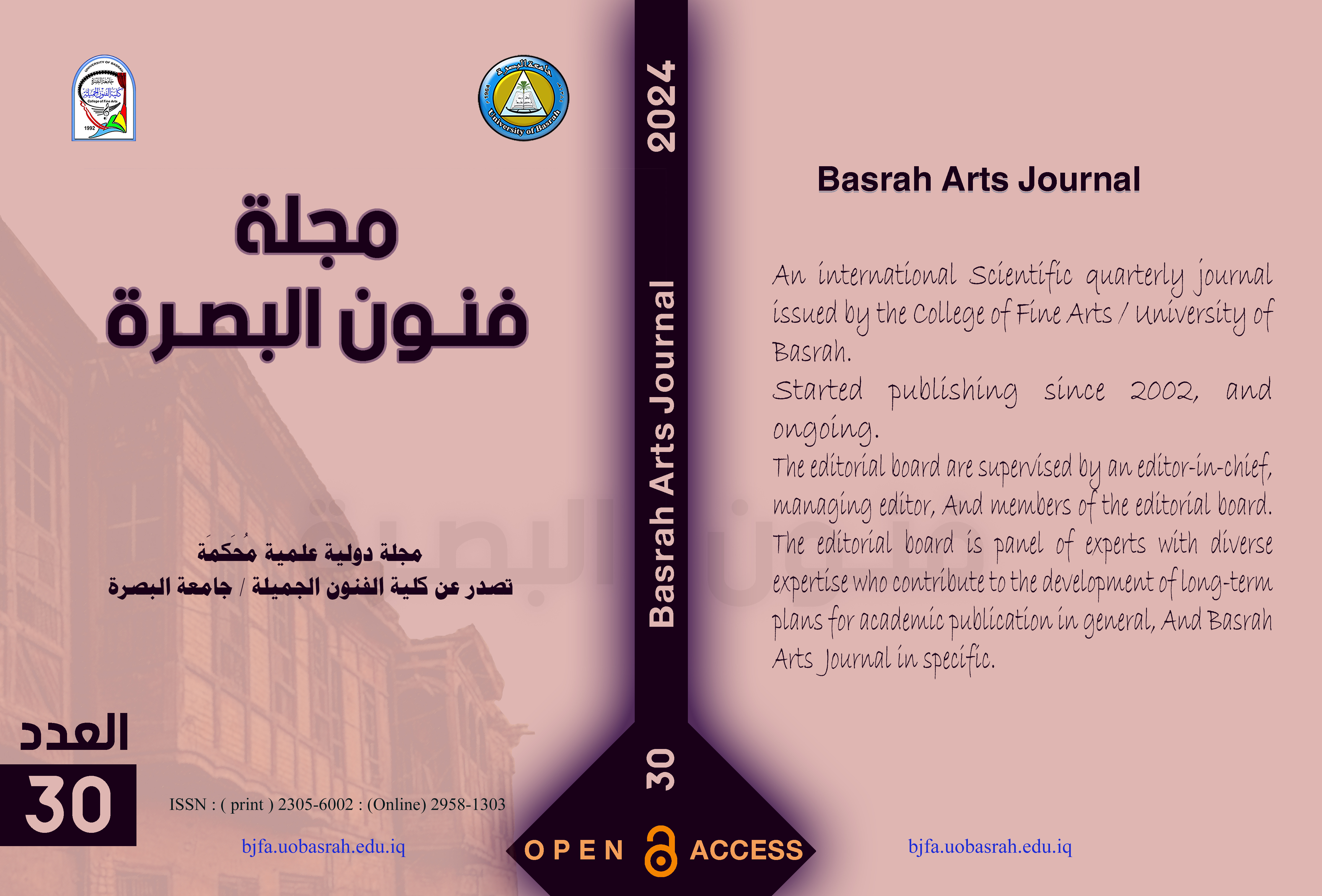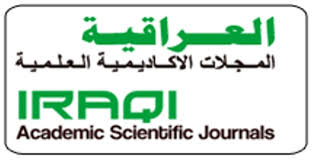Technical Alienation in Contemporary Global Sculpture
DOI:
https://doi.org/10.59767/2024.08/30.5Keywords:
alienation, technique, sculpture, World, contemporaryAbstract
The research was concerned with studying technical alienation in contemporary global sculpture, as alienation is a concept that gained an important place due to its connection with humans and then moved to different fields, including art. Accordingly, the study was built on four chapters. The first chapter included: the research problem that ended with the following question (What are the uses of technical alienation in contemporary global sculpture)? It also included the importance of research and the need for it, as well as the goal of the research and the limits of the research, and then defining the terms mentioned in the title and defining them linguistically, terminologically and procedurally. As for the second chapter: it included two sections: The first section: by studying the concept of alienation in philosophical thought and what its manifestations are. The second section: was concerned with studying the representations of alienation in contemporary global sculpture. The chapter concluded by reviewing the indicators of the theoretical framework to benefit from them in analyzing the research sample. As for the third section: it included the research community. His sample, the research tool. The fourth chapter: included the results of the research, its discussion, and its conclusions. Among the results reached by the researcher are:
1. The phenomenon of alienation reflected different states of representation depending on the level of alienation, its time, and its social place that did not belong to its paths. It constituted a realistic (material) representation of the sculptor’s state of separation from the surroundings of his community, embodied in the sculptural treatments of his works.
2. The state of alienation for the sculptor was represented by an internal struggle between two active tendencies, the first represented by his desires, while the second was founded on his needs that could not be satisfied, in order to contribute to a creative, sculptural product to bring them out (the state of alienation). Therefore, the state of alienation is considered a type of active orientation (alienation). Positive) It resulted in sculptural works with a creative path.
References
Al Wad, A. S., & Al Hatami, A. A. (2011). The Conceptual and Aesthetic Dimensions of Dada and Its Repercussions in Postmodern Art (Vol. 1st edition). Amman, Jordan: Dar Al Sadiq Cultural Foundation.
Al Wadi , A. S. (2009). Studies in Visual Aesthetic Discourse (Vol. 1st edition). Baghdad, Iraq: House of General Cultural Affairs.
Al-Basiouni , M. (nd). Art in the Twentieth Century. Sharjah, The United Arab Emirates: Sharjah Center for Intellectual Creativity.
Aldaghlawy, H. J. (2024). The aesthetics of forming acting performance in children's theater performances. Al-Academy(112), 209-222. doi:https://doi.org/10.35560/jcofarts1262
Aldaghlawy, H. J. (2024). Visual rhythm in the Iraqi theatrical performance. Journal of Arts and Cultural Studies, 3(1), 1-9. doi:https://doi.org/10.23112/acs24021201
AlHajj, D. (2014). Necessity and Freedom - A Reading in Spinoza's Philosophy. Algeria: Difference Publications.
Al-Hassan, M. I. (1998). Pioneers of Social Thought. Baghdad, Iraq: Dar Al-Hikma for Printing and Publishing.
Al-Hatemi, A. A. (2013). Technology of Expression in the Formation of Postmodernism (Vol. 1st edition). Amman, Jordan: Dar Al-Radwan for Publishing and Distribution.
Al-Nouri, Q. (1979). Alienation as a Terms, Concept, and Reality. Kuwait: Alam Al-Fikr Magazine.
Al-Razi, M. A. (1981). Mukhtar Al-Sahhah. Beirut, Lebanon: Dar Al-Kitab Al-Arabi.
Al-Saleh, S. A.-A., & Suleiman, A. A.-S. (nd). Al-Safi Dictionary of the Arabic Language. Lebanon, Beirut: Dar Al-Fikr.
Al-Yousef, M. A. (2011). The Sociology of Alienation - A Critical Reading in the Philosophy of Alienation. Baghdad, Iraq: House of General Cultural Affairs.
Amhaz, M. (1981). Contemporary Fine Art _ Photography (1870_1970). Beirut, Lebanon: Dar Al-Muthalath for Design Printing and Publishing.
Ayed, N. Y. (2011). References of Form in Postmodern Formation. Baghdad, Iraq: unpublished master’s thesis, drawing, College of Fine Arts, University of Baghdad.
Barhiya , E. (1985). History of Philosophy. (G. Tarabishi, Trans.) Beirut, Lebanon: Dar Al-Tali’ah.
Bishara , S. (1983). The Psychological Phenomenon according to Freud. Beirut, Lebanon: Journal of Contemporary Arab Thought.
Durant, W. (1988). The Story of Philosophy from Plato to John Dewey (Vol. 6th edition). (F. A. Al-Mushasha, Trans.) Beirut, Lebanon: Al-Ma’rif Library.
Iskandar, N. R. (1988). Alienation and the Crisis of Contemporary Man. Alexandria, Egypt: University Knowledge House.
Kamel, F. (1963). The Concise Philosophical Encyclopedia. Cairo, Egypt: Anglo-Egyptian Library.
Kurzweil, E. (1985). The Age of Structuralism. (J. Asfour, Trans.) Baghdad, Iraq: Arab Horizons Press and Publishing House.
Maalouf, L. (1996). Al-Munajjid fi Language and Media. Beirut, Lebanon: Dar Al-Mashreq.
Masoud, G. (1995). Al-Raed, a modern linguistic dictionary (Vol. 2nd edition). Lebanon, Beirut: Dar Al-Ilm Lil-Malayin.
Mullen, A. (2015). Otto Dix’s The Trench and Anti-War Art in Post-World War I Germany.
Munro, T. (1971). Development in the Arts. (M. A. Abu Durra, Trans.) Cairo, Egypt: Egyptian General Authority for Copyright and Publishing.
Murray, A. (2014). A War of Images: Otto Dix and the Myth of the War Experience.
Nehme, A., & And others. (2000). Al-Munjid in the Contemporary Arabic Language (Vol. 1st edition). Beirut: Dar Al-Mashreq.
Orley, H. H. (2018). Otto Dix. https://www.moma.org/artists/1559.
Saeed, A. M. (1990). Artistic Psychology. Baghdad: Ministry of Higher Education and Scientific Research.
Samira, S. (2000). Alienation in Abbasid Poetry. Damascus, Syria: Al-Yanabi’ Publishing House.
Shukri, L. (2019, 10 13). Otto Dix; The real picture of war. Tanja: https://www.alaraby.co.uk/%D8%A3%D9%88%D8%AA%D9%91%D9%88-%D8%AF%D9%8A%D9%83%D8%B3-%D8%A7%D9%84%D8%B5%D9%88%D8%B1%D8%A9-%D8%A7%D9%84%D8%AD%D9%82%D9%8A%D9%82%D9%8A%D8%A9-%D9%84%D9%84%D8%AD%D8%B1%D8%A8.
Soussan, G. B., & Gerard. (2003). The Critical Dictionary of Marxism (Vol. 1st edition). (Collective translation, Trans.) Beirut, Lebanon: Al-Farabi Publishing House.
Ted, H. (vol 2, 2021). The Oxford Handbook of Philosophy. (N. Al-Hasadi, Trans.) Manama: Bahrain Authority for Culture and Antiquities.
Tharwat, A. (2014). Complex Artwork (Vol. 1st edition). Cairo, Egypt: General Authority for Cultural Palaces.
Wahba, M. (1998). The Philosophical Dictionary. Cairo: Qubaa House for Printing, Publishing and Distribution.
Xeris, T. (1987). Socrates (Vol. 1st edition). (T. Al-Suhail, Trans.) Beirut, Lebanon: Al-Farabi Publishing House.
Youssef, M. A. (2024). The controversy of thought in performance and its representation in contemporary formation between rationalism and empiricism. Baghdad, Iraq: unpublished doctoral thesis, drawing, College of Fine Arts, University of Baghdad.
Ziadeh, M. (1986). Beirut, Lebanon: he Arab Philosophical Encyclopedia, Arab Development Institute.
Downloads
Published
How to Cite
License
Copyright (c) 2024 Khawla Ghadban Obaid (Author)

This work is licensed under a Creative Commons Attribution 4.0 International License.







